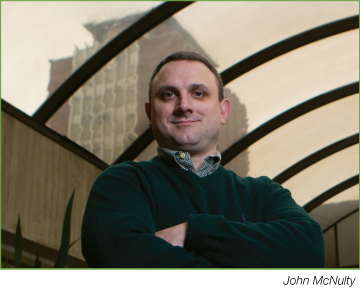page 1 | page 2
But while it cut expenses for the county, that decision created another kind of “cost” for about 3.6 million registered voters who would have to cast their votes away from their accustomed polling places. Examining election records after the fact, McNulty and Brady found that this inconvenience factor did keep some voters away.

People who had to go to an unfamiliar polling place, they determined, were 3 percent less likely to turn up at the polls than people who could vote where they always did. Of the 3 percent who didn’t make the trip, about half took advantage of California’s liberal absentee balloting laws to vote by mail. “The other half abstained. So you had a net turnout dropoff of about 1.5 percent,” McNulty said.
The NSF-funded book will extend this study with research on elections held in Los Angeles and several other California counties, plus selected locations in other states, including New York, from 2002 to 2006. McNulty and Brady will compare the turnout that counties saw when they employed the standard number of polling places and when they tried to save money by opening fewer polls.
Those comparisons are relatively easy to make in California, which held another statewide special election in 2005, this time on a slate of ballot initiatives. For that contest, Los Angeles County again opened only about 2,000 polling sites, McNulty said. During regular elections in 2002 and 2004, it employed its typical complement of roughly 5,000 sites.
McNulty and Brady also hope to pinpoint how changes in polling places affect specific groups of voters. “We’ll be able to isolate old from young,” McNulty said. “We’ll be able to isolate a long-term voter from a short-term voter. We’ll be able to isolate the frequent voter from the occasional voter. And, making some inferences from geography, we can make judgments about relative effects on different socio-economic strata.” Information for this analysis comes from voter rolls, which include addresses, birth dates, party registrations and voting histories.
With this breakdown, the study could have implications for efforts to get college-age voters to the polls, an effort McNulty terms “one of the great white whales of political consultants.”

For the future, McNulty plans to investigate early voting. This practice, legal in more than half the states, allows people to vote in advance of Election Day, using systems set up in public locations such as shopping malls. Some observers believe early voting increases turnout by making it easier to vote; others think it cannibalizes Election Day voting, attracting mainly people who would have voted anyway, and leaving overall turnout unchanged, McNulty said.
McNulty plans to study whether offering early voting in different kinds of locations might increase turnout. “There’s some indication that putting polls into places like Wal-Mart might not be a cannibalizing initiative,” he said.
While not everyone frequents traditional malls, in some communities just about everyone shops at Wal-Mart. “And if you happen to be there and there’s not much of a wait, it’s seems like it would be fairly costless to vote,” McNulty speculates. “I want to find out if that’s true, and if so, what difference it makes.”
— Merrill Douglas
page 1 | page 2